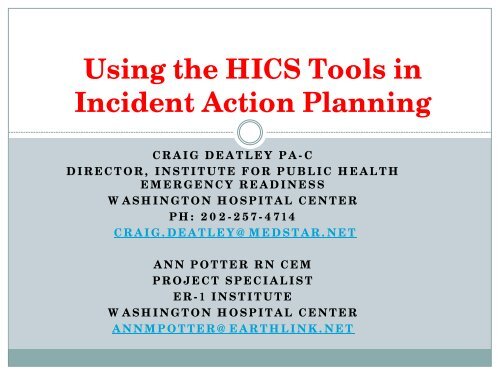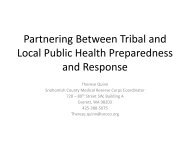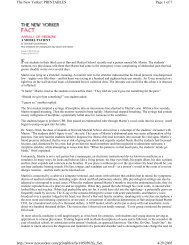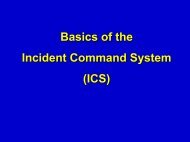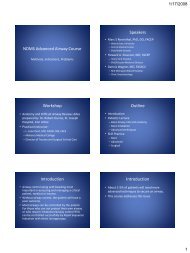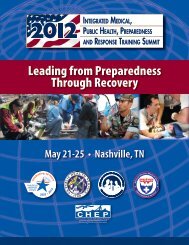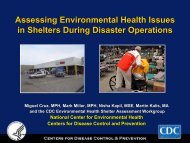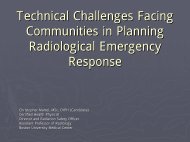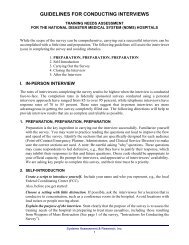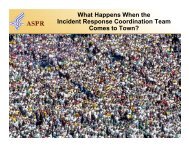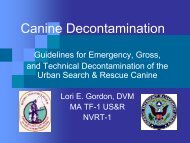Using the HICS Tools in Incident Action Planning - The 2012 ...
Using the HICS Tools in Incident Action Planning - The 2012 ...
Using the HICS Tools in Incident Action Planning - The 2012 ...
Create successful ePaper yourself
Turn your PDF publications into a flip-book with our unique Google optimized e-Paper software.
<strong>Us<strong>in</strong>g</strong> <strong>the</strong> <strong>HICS</strong> <strong>Tools</strong> <strong>in</strong><br />
<strong>Incident</strong> <strong>Action</strong> Plann<strong>in</strong>g<br />
CRAIG DEATLEY PA- C<br />
DIRECTOR, INSTITUTE FOR PUBLIC HEALTH<br />
EMERGENCY READINESS<br />
WASHINGTON HOSPITAL CENTER<br />
PH: 202- 257- 4714<br />
CRAIG.DEATLEY@MEDSTAR.NET<br />
ANN POTTER RN CEM<br />
PROJECT SPECIALIST<br />
ER- 1 INSTITUTE<br />
WASHINGTON HOSPITAL CENTER<br />
ANNMPOTTER@EARTHLINK.NET
Objectives<br />
• Discuss <strong>the</strong> process of <strong>in</strong>cident action plann<strong>in</strong>g<br />
• Practice complet<strong>in</strong>g an <strong>Incident</strong> <strong>Action</strong> Plan<br />
• Review <strong>the</strong> Hospital <strong>Incident</strong> Command System<br />
(<strong>HICS</strong>) tools available to assist <strong>in</strong> <strong>in</strong>cident action<br />
plann<strong>in</strong>g<br />
• Develop and utilize <strong>Incident</strong> <strong>Action</strong> Plans for<br />
hospital based response
<strong>HICS</strong> Form 214:<br />
Operational<br />
Log<br />
<strong>HICS</strong> 214 – OPERATIONAL LOG<br />
1. INCIDENT NAME 2. DATE/TIME PREPARED 3. OPERATIONAL PERIOD DATE/TIME<br />
4. SECTION /BRANCH 5. POSITION<br />
6. ACTIVITY LOG<br />
Time<br />
Major Events, Decisions Made, and Notifications Given<br />
7. PREPARED BY (sign and pr<strong>in</strong>t)<br />
8. FACILITY NAME. <strong>HICS</strong> 214
:<br />
<strong>Incident</strong> <strong>Action</strong><br />
Plann<strong>in</strong>g Process
Importance of Plann<strong>in</strong>g<br />
• Maximize <strong>the</strong> available resources<br />
• Reduce and prevent duplication of efforts<br />
• Reduce costs<br />
• Improve and enhance communication<br />
• Increase effectiveness of response and recovery<br />
actions<br />
• Ensure understand<strong>in</strong>g of <strong>the</strong> strategic direction
<strong>Incident</strong> <strong>Action</strong> Plann<strong>in</strong>g Process<br />
• Core concept that takes place regardless of <strong>the</strong><br />
<strong>in</strong>cident size or complexity<br />
• Management by objectives will facilitate response<br />
and recovery<br />
• Involves 6 step process …
Step 1<br />
1. Understand<strong>in</strong>g <strong>the</strong> hospital’s policy and<br />
direction<br />
o<br />
Can you care for burn patients Are you set to be a<br />
casualty collection po<strong>in</strong>t What are your<br />
decontam<strong>in</strong>ation capabilities Do you have alternate<br />
care sites Can you accept forensic patients Do you<br />
have an austere care policy What is your ability to<br />
surge Can you provide negative isolation Can you<br />
track exposed patients<br />
2. Assess<strong>in</strong>g <strong>the</strong> situation<br />
3. Establish<strong>in</strong>g <strong>the</strong> <strong>in</strong>cident objectives<br />
4. Determ<strong>in</strong><strong>in</strong>g appropriate strategies to achieve <strong>the</strong> objectives<br />
5. Giv<strong>in</strong>g tactical direction and ensur<strong>in</strong>g that it is followed<br />
6. Provid<strong>in</strong>g necessary support
Step 2<br />
1. Understand<strong>in</strong>g <strong>the</strong> hospital’s policy and direction<br />
2. Assess<strong>in</strong>g <strong>the</strong> situation<br />
o<br />
How do you verify or validate <strong>in</strong>formation What<br />
are your l<strong>in</strong>ks to community partners How do<br />
you communicate <strong>in</strong>ternally What are <strong>the</strong><br />
policies and procedures for <strong>in</strong>ternal hospital<br />
assessment What relationships exist for preevent<br />
<strong>in</strong>telligence Do you have MOUs with<br />
response agencies Are you <strong>in</strong> <strong>the</strong> loop for<br />
notification of threats or actual events<br />
3. Establish<strong>in</strong>g <strong>the</strong> <strong>in</strong>cident objectives<br />
4. Determ<strong>in</strong><strong>in</strong>g appropriate strategies to achieve <strong>the</strong> objectives<br />
5. Giv<strong>in</strong>g tactical direction and ensur<strong>in</strong>g that it is followed<br />
6. Provid<strong>in</strong>g necessary support
Step 3<br />
1. Understand<strong>in</strong>g <strong>the</strong> hospital’s policy and direction<br />
2. Assess<strong>in</strong>g <strong>the</strong> situation<br />
3. Establish<strong>in</strong>g <strong>the</strong> <strong>in</strong>cident objectives<br />
o<br />
o<br />
o<br />
Determ<strong>in</strong>e overall priorities based on hospital policy and<br />
situational assessment<br />
Set <strong>the</strong> operational period<br />
Name <strong>the</strong> event<br />
4. Determ<strong>in</strong><strong>in</strong>g appropriate strategies to achieve <strong>the</strong> objectives<br />
5. Giv<strong>in</strong>g tactical direction and ensur<strong>in</strong>g that it is followed<br />
6. Provid<strong>in</strong>g necessary support
Step 4<br />
1. Understand<strong>in</strong>g <strong>the</strong> hospital’s policy and direction<br />
2. Assess<strong>in</strong>g <strong>the</strong> situation<br />
3. Establish<strong>in</strong>g <strong>the</strong> <strong>in</strong>cident objectives<br />
4. Determ<strong>in</strong><strong>in</strong>g appropriate strategies to<br />
o<br />
o<br />
achieve <strong>the</strong> objectives<br />
How to get th<strong>in</strong>gs done: <strong>in</strong>volve <strong>the</strong> response and support<br />
partners <strong>in</strong> determ<strong>in</strong><strong>in</strong>g strategies to carry out <strong>the</strong> mission<br />
Develop objectives that are Simple, Measurable,<br />
Achievable, Realistic, Time Sensitive and Task Oriented<br />
5. Giv<strong>in</strong>g tactical direction and ensur<strong>in</strong>g that it is followed<br />
6. Provid<strong>in</strong>g necessary support
Step 5<br />
1. Understand<strong>in</strong>g <strong>the</strong> hospital’s policy and direction<br />
2. Assess<strong>in</strong>g <strong>the</strong> situation<br />
3. Establish<strong>in</strong>g <strong>the</strong> <strong>in</strong>cident objectives<br />
4. Determ<strong>in</strong><strong>in</strong>g appropriate strategies to achieve <strong>the</strong> objectives<br />
5. Giv<strong>in</strong>g tactical direction and ensur<strong>in</strong>g that it<br />
is followed<br />
o<br />
o<br />
o<br />
o<br />
o<br />
Select effective strategies and tactics<br />
Issue assignments<br />
Develop realistic timeframes for completion<br />
Measure <strong>the</strong> response: cont<strong>in</strong>uous evaluation of actions taken<br />
Revise tactics based on success or roadblocks<br />
6. Provid<strong>in</strong>g necessary support
Step 6<br />
1. Understand<strong>in</strong>g <strong>the</strong> hospital’s policy and direction<br />
2. Assess<strong>in</strong>g <strong>the</strong> situation<br />
3. Establish<strong>in</strong>g <strong>the</strong> <strong>in</strong>cident objectives<br />
4. Determ<strong>in</strong><strong>in</strong>g appropriate strategies to achieve <strong>the</strong> objectives<br />
5. Giv<strong>in</strong>g tactical direction and ensur<strong>in</strong>g that it is followed<br />
6. Provid<strong>in</strong>g necessary support<br />
o<br />
o<br />
o<br />
o<br />
Supplies, equipment, personnel, sites<br />
Staff, stuff, space<br />
Project <strong>the</strong> requirements based on situational and ongo<strong>in</strong>g<br />
assessments<br />
Ensur<strong>in</strong>g command level awareness of support needs and<br />
projections
Management by Objectives<br />
Command and Control<br />
› Broad organizational objectives<br />
› Not limited to an operational period<br />
› Do not change throughout <strong>the</strong> response and recovery phases<br />
› Set by <strong>the</strong> <strong>Incident</strong> Commander
Objectives<br />
Strategic Objectives<br />
› Steps to be accomplished dur<strong>in</strong>g <strong>the</strong> def<strong>in</strong>ed operational<br />
period<br />
› Specific objectives to achieve <strong>the</strong> command and control<br />
objectives<br />
› Vary across <strong>the</strong> sections<br />
› Identify needed resources to carryout <strong>the</strong> objectives
Objectives<br />
<br />
Tactical Objectives<br />
› How it gets done<br />
› Specific directions, orders, assignments to be carried out<br />
› Evaluated for effectiveness and achievement
Major Severe Wea<strong>the</strong>r<br />
Widespread Damage Across<br />
<strong>the</strong> County<br />
Command and Control<br />
Strategies<br />
Tactics
Command and Control Objective: Provide care for<br />
<strong>in</strong>patients, casualties and hospital staff<br />
Operations<br />
Section Strategic Objective Tactics<br />
•Activate alternate care sites<br />
for evacuated patients<br />
•Assess facility for damage<br />
and <strong>in</strong>itiate repairs<br />
•Activate damage teams to assess<br />
impact on patient care areas and<br />
designated alternate care sites<br />
•Activate <strong>in</strong>ternal damage<br />
assessment plan for all offices<br />
and non-cl<strong>in</strong>ical areas to<br />
determ<strong>in</strong>e use for patient care<br />
Plann<strong>in</strong>g<br />
Logistics<br />
•Develop <strong>in</strong>cident action<br />
plan <strong>in</strong> collaboration with<br />
<strong>Incident</strong> Commander<br />
•Inventory and assess for<br />
damage all supplies,<br />
equipment, food and<br />
water resources<br />
•Ga<strong>the</strong>r situational<br />
<strong>in</strong>formation from community<br />
partners<br />
•Notify all sections to provide<br />
staff<strong>in</strong>g names<br />
•Notify department heads to<br />
<strong>in</strong>ventory all designated<br />
emergency supplies and<br />
equipment and report<br />
damages and shortages
Identify Resources and Assignments<br />
• Activate Hospital Command Center (HCC) positions<br />
needed for <strong>the</strong> response<br />
• Identify needed personnel tra<strong>in</strong>ed to fill HCC roles<br />
• Assign staff for <strong>in</strong>cident specific response<br />
◦ Triage<br />
◦ Structural assessment<br />
◦ Evacuation
Ongo<strong>in</strong>g Evaluation and Revision<br />
• Was <strong>the</strong> strategy effective<br />
• Are <strong>the</strong> tactics safe Are staff, patients or<br />
community responders at risk when <strong>the</strong>y carry out<br />
<strong>the</strong> tactics<br />
• Are staff stressed Are <strong>the</strong>re sufficient numbers<br />
• Are additional strategies and tactics needed to meet<br />
<strong>the</strong> command objective
Documentation<br />
IAP must be <strong>in</strong> writ<strong>in</strong>g<br />
› Provides a common set of objectives<br />
› Provides a framework for response<br />
› Enhances communication among HCC staff<br />
› Enhances communication with response partners<br />
› Provides a tool for evaluation of <strong>the</strong> response; archive of<br />
actions taken and effectiveness of <strong>the</strong> response (After <strong>Action</strong><br />
Report/Improvement Plan)<br />
› Risk management tool: “if it wasn’t written down…”
Implement Corrective <strong>Action</strong>s<br />
Corrective action plann<strong>in</strong>g is an ongo<strong>in</strong>g process<br />
If it isn't work<strong>in</strong>g, identify <strong>the</strong> problem and develop<br />
new strategies<br />
Assess impact of actions taken on <strong>the</strong> hospital: is it<br />
positive or negative<br />
Use <strong>the</strong> <strong>Incident</strong> <strong>Action</strong> Plann<strong>in</strong>g process to<br />
evaluate <strong>the</strong> response, identify new strategies and<br />
resources and correct <strong>the</strong> process
:<br />
<strong>Us<strong>in</strong>g</strong> <strong>the</strong> <strong>HICS</strong> <strong>Tools</strong>:<br />
<strong>Incident</strong> Response<br />
Guides
<strong>Incident</strong> Response Guides<br />
Specific objectives, strategies and tactics for <strong>the</strong><br />
identified event<br />
Activated dur<strong>in</strong>g <strong>the</strong> response<br />
Provide critical considerations and actions steps for<br />
Command and General staff<br />
Time based <br />
› Immediate 0-2 hrs<br />
› Intermediate 2-12 hrs<br />
› Extended ≥ 12 hours and beyond<br />
› Demobilization and System Recovery
<strong>Incident</strong> Response Guides<br />
• Identify <strong>in</strong>itial actions<br />
• Serve as a documentation tool<br />
• Identifies actions for Command and General staff as<br />
well as section specific<br />
• Facilitates <strong>in</strong>cident action plann<strong>in</strong>g
External IRG: Severe wea<strong>the</strong>r<br />
Mission: To ma<strong>in</strong>ta<strong>in</strong> hospital operations for a m<strong>in</strong>imum of 72<br />
hours follow<strong>in</strong>g a major earthquake that may impact <strong>the</strong> structural<br />
<strong>in</strong>tegrity of <strong>the</strong> facility, and to ensure <strong>the</strong> cont<strong>in</strong>uum of care for<br />
patients, visitors, and casualties of <strong>the</strong> event.<br />
Directions<br />
Read this entire response guide and review organization chart.<br />
Use this response guide as a checklist to ensure all tasks are<br />
addressed and completed.<br />
Objectives<br />
Damage Assessment<br />
Patients, visitors, staff assessed for <strong>in</strong>juries and accounted for<br />
Patient track<strong>in</strong>g<br />
Hospital facility self-susta<strong>in</strong>ment for a m<strong>in</strong>imum of 72 hours
Immediate <strong>Action</strong>s (Operational Period 0-2 Hours)<br />
COMMAND<br />
<strong>Incident</strong> Commander:<br />
Activate <strong>the</strong> facility Emergency Operations Plan<br />
Appo<strong>in</strong>t Plann<strong>in</strong>g, Operations and Logistics Section Chiefs<br />
Appo<strong>in</strong>t Medical Technical Specialists – Hospital Adm<strong>in</strong>istration,<br />
Cl<strong>in</strong>ic Adm<strong>in</strong>istration and Risk Management, as appropriate<br />
Liaison Officer:<br />
Communicate with local Emergency Operations Center and officials<br />
to determ<strong>in</strong>e extent of damage to critical <strong>in</strong>frastructure and services<br />
Communicate with o<strong>the</strong>r hospitals to determ<strong>in</strong>e status<br />
Coord<strong>in</strong>ate and communicate with (regional) HCC or equivalent;<br />
notify as appropriate<br />
Public Information Officer:<br />
Obta<strong>in</strong> <strong>in</strong>formation from Situation Unit Leader to provide situation<br />
brief<strong>in</strong>g to hospital patients, visitors, and staff
Immediate <strong>Action</strong>s (Operational Period 0-2<br />
Hours)<br />
OPERATIONS<br />
Activate alternate care sites for evacuated patients<br />
Implement evacuation of unsafe/unstable areas of <strong>the</strong> facility<br />
Assess facility for damage, <strong>in</strong>itiate repairs as appropriate or<br />
secure unsafe areas<br />
Activate search procedures as appropriate<br />
Assess status of security systems, access and egress from<br />
facility, and implement security plan<br />
Prepare to receive <strong>in</strong>cident casualties; establish triage and<br />
treatment areas, discharge areas and appropriate protocols<br />
Conduct an census of <strong>in</strong>patients, cl<strong>in</strong>ic patients, those<br />
available for discharge<br />
Ensure cont<strong>in</strong>ued function<strong>in</strong>g of emergency power<br />
generators<br />
Consider activat<strong>in</strong>g HazMat Branch if any facility damage<br />
result<strong>in</strong>g <strong>in</strong> hazardous materials spill or <strong>in</strong>cident
Immediate <strong>Action</strong>s (Operational Period 0-2 Hours)<br />
PLANNING<br />
Initiate patient, bed, materiel and personnel track<strong>in</strong>g<br />
procedures<br />
Establish operational periods and develop <strong>Incident</strong> <strong>Action</strong><br />
Plan <strong>in</strong> collaboration with <strong>the</strong> <strong>Incident</strong> Commander<br />
LOGISTICS<br />
Inventory and assess for damage all supplies, equipment,<br />
food and water stores<br />
Activate alternate communication systems and establish<br />
contact with local EOC, EMS and ensure <strong>in</strong>tra-hospital<br />
communications with walkie talkies, runners, etc.<br />
Project needs for 72 hours and <strong>in</strong>stitute ration<strong>in</strong>g, if<br />
appropriate.
O<strong>the</strong>r Po<strong>in</strong>ts About <strong>Incident</strong><br />
Response Guide<br />
• IRG cont<strong>in</strong>ues through demobilization and system<br />
recovery phases (expanded concept with<strong>in</strong> <strong>HICS</strong><br />
guidance)<br />
• Identifies actions for return to normal operations<br />
• Enhances after action review and corrective<br />
improvement: clos<strong>in</strong>g <strong>the</strong> loop
Demobilization/System Recovery<br />
PLANNING<br />
Prepare a summary of response operations, <strong>in</strong>clud<strong>in</strong>g number of patients<br />
received, status and current census<br />
Write an after-action report <strong>in</strong>clud<strong>in</strong>g <strong>the</strong>se topics:<br />
Summary of <strong>the</strong> <strong>in</strong>cident<br />
Response activities that went well<br />
Response activities that need improvement<br />
Recommendations for future actions<br />
LOGISTICS<br />
Restock supplies, equipment and medications to normal levels<br />
Compile a f<strong>in</strong>al facility damage and repair report<br />
Conduct stress manage services and debrief<strong>in</strong>gs for staff, as appropriate<br />
FINANCE<br />
Prepare a f<strong>in</strong>al summary of response costs and expenditures for approval by <strong>the</strong><br />
<strong>Incident</strong> Commander<br />
Submit claims to <strong>in</strong>surance companies, as appropriate<br />
Submit patient records and o<strong>the</strong>r appropriate <strong>in</strong>formation for reimbursement
IRG plann<strong>in</strong>g tool:<br />
HCC staff<strong>in</strong>g<br />
Public<br />
Information<br />
Officer<br />
<strong>Incident</strong> Commander<br />
Safety<br />
Officer<br />
Immediate<br />
Phase 0-2 hrs<br />
Operations<br />
Section Chief<br />
Liaison<br />
Officer<br />
Plann<strong>in</strong>g<br />
Section Chief<br />
Medical/<br />
Technical<br />
Specialist<br />
Logistics<br />
Section Chief<br />
Biological/Infectious Disease<br />
Chemical<br />
Radiological<br />
Cl<strong>in</strong>ic Adm<strong>in</strong>istration<br />
Hospital Adm<strong>in</strong>istration<br />
Legal Affairs<br />
Risk Management<br />
Medical Staff<br />
Pediatric Care<br />
Medical Ethicist<br />
F<strong>in</strong>ance/<br />
Adm<strong>in</strong>istration<br />
Section Chief<br />
Stag<strong>in</strong>g<br />
Manager<br />
Personnel<br />
Vehicle<br />
Equipment/Supply<br />
Medication<br />
Resources<br />
Unit Leader<br />
Personnel Track<strong>in</strong>g<br />
Materiel Track<strong>in</strong>g<br />
Service<br />
Branch Director<br />
Communications Unit<br />
IT/IS Unit<br />
Staff Food & Water Unit<br />
Time<br />
Unit Leader<br />
Medical Care<br />
Branch Director<br />
Inpatient Unit<br />
Outpatient Unit<br />
Casualty Care Unit<br />
Mental Health Unit<br />
Cl<strong>in</strong>ical Support Services Unit<br />
Patient Registration Unit<br />
Situation<br />
Unit Leader<br />
Patient Track<strong>in</strong>g<br />
Bed Track<strong>in</strong>g<br />
Support<br />
Branch<br />
Director<br />
Employee Health & Well-Be<strong>in</strong>g Unit<br />
Family Care Unit<br />
Supply Unit<br />
Facilities Unit<br />
Transportation Unit<br />
Labor Pool & Credential<strong>in</strong>g Unit<br />
Procurement<br />
Unit Leader<br />
Infrastructure<br />
Branch Director<br />
Power/Light<strong>in</strong>g Unit<br />
Water/Sewer Unit<br />
HVAC Unit<br />
Build<strong>in</strong>g/Grounds Damage Unit<br />
Medical Gases Unit<br />
Medical Devices Unit<br />
Environmental Services Unit<br />
Food Services Unit<br />
Documentation<br />
Unit Leader<br />
Compensation/<br />
Claims<br />
Unit Leader<br />
HazMat<br />
Branch Director<br />
Detection and Monitor<strong>in</strong>g Unit<br />
Spill Response Unit<br />
Victim Decontam<strong>in</strong>ation Unit<br />
Facility/Equipment<br />
Decontam<strong>in</strong>ation Unit<br />
Demobilization<br />
Unit Leader<br />
Cost<br />
Unit Leader<br />
Security<br />
Branch Director<br />
Access Control Unit<br />
Crowd Control Unit<br />
Traffic Control Unit<br />
Search Unit<br />
Law Enforcement Interface Unit<br />
Bus<strong>in</strong>ess<br />
Cont<strong>in</strong>uity<br />
Branch Director<br />
Information Technology Unit<br />
Service Cont<strong>in</strong>uity Unit<br />
Records Preservation Unit<br />
Bus<strong>in</strong>ess Function Relocation Unit<br />
Legend<br />
Activated Position
IRG plann<strong>in</strong>g tool:<br />
HCC staff<strong>in</strong>g<br />
Public<br />
Information<br />
Officer<br />
<strong>Incident</strong> Commander<br />
Safety<br />
Officer<br />
Demobilization /<br />
System Recovery<br />
Operations<br />
Section Chief<br />
Liaison<br />
Officer<br />
Plann<strong>in</strong>g<br />
Section Chief<br />
Medical/<br />
Technical<br />
Specialist<br />
Logistics<br />
Section Chief<br />
Biological/Infectious Disease<br />
Chemical<br />
Radiological<br />
Cl<strong>in</strong>ic Adm<strong>in</strong>istration<br />
Hospital Adm<strong>in</strong>istration<br />
Legal Affairs<br />
Risk Management<br />
Medical Staff<br />
Pediatric Care<br />
Medical Ethicist<br />
F<strong>in</strong>ance/<br />
Adm<strong>in</strong>istration<br />
Section Chief<br />
Stag<strong>in</strong>g<br />
Manager<br />
Personnel<br />
Vehicle<br />
Equipment/Supply<br />
Medication<br />
Resources<br />
Unit Leader<br />
Personnel Track<strong>in</strong>g<br />
Materiel Track<strong>in</strong>g<br />
Service<br />
Branch Director<br />
Communications Unit<br />
IT/IS Unit<br />
Staff Food & Water Unit<br />
Time<br />
Unit Leader<br />
Medical Care<br />
Branch Director<br />
Inpatient Unit<br />
Outpatient Unit<br />
Casualty Care Unit<br />
Mental Health Unit<br />
Cl<strong>in</strong>ical Support Services Unit<br />
Patient Registration Unit<br />
Situation<br />
Unit Leader<br />
Patient Track<strong>in</strong>g<br />
Bed Track<strong>in</strong>g<br />
Support<br />
Branch<br />
Director<br />
Employee Health & Well-Be<strong>in</strong>g Unit<br />
Family Care Unit<br />
Supply Unit<br />
Facilities Unit<br />
Transportation Unit<br />
Labor Pool & Credential<strong>in</strong>g Unit<br />
Procurement<br />
Unit Leader<br />
Infrastructure<br />
Branch Director<br />
Power/Light<strong>in</strong>g Unit<br />
Water/Sewer Unit<br />
HVAC Unit<br />
Build<strong>in</strong>g/Grounds Damage Unit<br />
Medical Gases Unit<br />
Medical Devices Unit<br />
Environmental Services Unit<br />
Food Services Unit<br />
Documentation<br />
Unit Leader<br />
Compensation/<br />
Claims<br />
Unit Leader<br />
HazMat<br />
Branch Director<br />
Detection and Monitor<strong>in</strong>g Unit<br />
Spill Response Unit<br />
Victim Decontam<strong>in</strong>ation Unit<br />
Facility/Equipment<br />
Decontam<strong>in</strong>ation Unit<br />
Demobilization<br />
Unit Leader<br />
Cost<br />
Unit Leader<br />
Security<br />
Branch Director<br />
Access Control Unit<br />
Crowd Control Unit<br />
Traffic Control Unit<br />
Search Unit<br />
Law Enforcement Interface Unit<br />
Bus<strong>in</strong>ess<br />
Cont<strong>in</strong>uity<br />
Branch Director<br />
Information Technology Unit<br />
Service Cont<strong>in</strong>uity Unit<br />
Records Preservation Unit<br />
Bus<strong>in</strong>ess Function Relocation Unit<br />
Legend<br />
Activated Position
<strong>Incident</strong> Response Guides<br />
• Kick start <strong>the</strong> response<br />
• Initiate <strong>Incident</strong> <strong>Action</strong> Plann<strong>in</strong>g<br />
• Provide recommendations for objectives and<br />
Hospital Command Center staff<strong>in</strong>g throughout <strong>the</strong><br />
response and recovery phases
<strong>Us<strong>in</strong>g</strong> <strong>the</strong> <strong>HICS</strong> <strong>Tools</strong>:<br />
IAP Forms
<strong>HICS</strong> Forms<br />
• FEMA forms used by emergency responders <strong>in</strong> <strong>the</strong><br />
field and at <strong>the</strong> Emergency Operations Center<br />
• Forms reviewed and customized for hospital use<br />
• Standardizes <strong>the</strong> hospital documentation and<br />
communication procedures<br />
• Facilitates response and communication with<br />
partners, coord<strong>in</strong>at<strong>in</strong>g entities and govern<strong>in</strong>g bodies
<strong>HICS</strong> IAP Forms<br />
• 20 forms developed<br />
• Facility specific forms can be added to augment <strong>the</strong><br />
<strong>Incident</strong> <strong>Action</strong> Plan and response and recovery<br />
phases<br />
• Standardized format<br />
• May be customized to your facility or healthcare<br />
system<br />
• May be completed electronically or <strong>in</strong> hard copy
What <strong>The</strong>y Have <strong>in</strong> Common<br />
• Form name and number<br />
• Purpose<br />
• Orig<strong>in</strong>ation<br />
• Copies (distribution)<br />
• When to complete<br />
• Helpful tips<br />
• Instructions for use<br />
• Facility customization
<strong>HICS</strong> Forms<br />
No. Name Responsible<br />
201 <strong>Incident</strong> Brief<strong>in</strong>g <strong>Incident</strong> Commander<br />
202 <strong>Incident</strong> Objectives Section Chiefs<br />
203 Organizational Assignment List Resource Unit Leader<br />
204 Branch Assignment List Branch Directors<br />
205 Communications Log Communications Unit Leader<br />
206 Staff Medical Plan Support Branch Director<br />
207 Organization Chart <strong>Incident</strong> Commander<br />
213 <strong>Incident</strong> Message Form All Positions<br />
214 Operational Log Command Staff and General<br />
Staff<br />
251 Facility System Status Report Infrastructure Branch<br />
Director
<strong>HICS</strong> Forms<br />
No. Name Responsible<br />
252 Section Personnel Time Sheet Section Chiefs<br />
253 Volunteer Staff Registration Labor Pool & Credentail<strong>in</strong>g Unit<br />
Leader<br />
254 Disaster Victim / Pt Track<strong>in</strong>g Form Patient Track<strong>in</strong>g Manager<br />
255 Master Pt Evacuation Track<strong>in</strong>g Form Patient Track<strong>in</strong>g Manager<br />
256 Procurement Summary Report Procurement Unit Leader<br />
257 Resource Account<strong>in</strong>g Record Section Chiefs<br />
258 Hospital Resource Directory Resource Unit Leader<br />
259 Hospital Casualty / Fatality Report Patient Track<strong>in</strong>g Manager<br />
260 Patient Evacuation Track<strong>in</strong>g Form Inpt Unit Leader Outpt Unit<br />
Leader, Casualty Care Unit Leader<br />
261 <strong>Incident</strong> <strong>Action</strong> Plan Safety Analysis Safety Officer
<strong>HICS</strong> Form 201<br />
Purpose: Document <strong>in</strong>itial response <strong>in</strong>formation<br />
and actions taken at start-up<br />
› Information received<br />
› HCC activation, positions <strong>in</strong> IMT, outside contacts made,<br />
special considerations…<br />
Orig<strong>in</strong>ation: <strong>Incident</strong> Commander<br />
› Or designee<br />
Copies to: Command staff, Section Chiefs,<br />
Documentation Unit Leader<br />
› Customize <strong>the</strong> distribution
Complete <strong>the</strong> 201<br />
• <strong>Incident</strong> Name: who names <strong>the</strong> <strong>in</strong>cident<br />
• Operational Period: who determ<strong>in</strong>es What factors<br />
should be considered<br />
• Date: yr/month/day<br />
• Time: 24 hour clock
Purpose: Document Initial response <strong>in</strong>formation and actions taken at<br />
startup<br />
Orig<strong>in</strong>ation: <strong>Incident</strong> Commander<br />
Copies to: Command Staff, Section Chiefs and Documentation Unit<br />
Leader<br />
<strong>HICS</strong> 201<br />
Page 2 of 2
What O<strong>the</strong>r Forms Should be Initially Completed <br />
• 202 <strong>Incident</strong> Objectives<br />
• 203 Organization Assignment List<br />
• 204 Branch Assignment List<br />
• 205 <strong>Incident</strong> Communications Plan<br />
• 206 Staff Medical Plan<br />
• 207 Organization Chart<br />
• 213 <strong>Incident</strong> Message Form<br />
• 214 Operational Log<br />
• 251 Facility System Status Report
<strong>Incident</strong> <strong>Action</strong> Plan<br />
Let’s review…<br />
• What forms make up <strong>the</strong> <strong>Incident</strong> <strong>Action</strong> Plan<br />
• Can additional forms be added<br />
• Can hospital specific forms be <strong>in</strong>cluded
• 252 Section Personnel Time Sheet<br />
• 253 Volunteer Staff Registration<br />
• 254 Disaster Victim / Pt Track<strong>in</strong>g Form<br />
• 255 Master Pt Evacuation Track<strong>in</strong>g Form<br />
• 256 Procurement Summary Report<br />
• 257 Resource Account<strong>in</strong>g Record<br />
• 258 Hospital Resource Directory<br />
• 259 Hospital Casualty / Fatality Report<br />
• 260 Patient Evacuation Track<strong>in</strong>g Form<br />
• 261 <strong>Incident</strong> <strong>Action</strong> Plan Safety Analysis
Exercise <strong>the</strong> Lessons<br />
Learned
Exercise #1: Internal Event<br />
Today is a Saturday on a three day holiday weekend.<br />
<strong>The</strong>re is a fire <strong>in</strong> several transponders <strong>in</strong> <strong>the</strong> ma<strong>in</strong><br />
power plant <strong>in</strong> <strong>the</strong> city; power fails <strong>in</strong> a 30 mile area.<br />
Power officials project that <strong>the</strong> power may not be<br />
restored for three days.<br />
Your hospital has lost all external power and<br />
emergency generators are supply<strong>in</strong>g emergency power<br />
to <strong>the</strong> facility. <strong>The</strong> hospital census is at 85% capacity.
What Now<br />
• Is an IAP <strong>in</strong>dicated Why<br />
• Is this a self limit<strong>in</strong>g event
What Else<br />
• What do we know; what have we done<br />
• Who do we need <strong>in</strong> <strong>the</strong> <strong>Incident</strong> Management Team<br />
• What are our objectives
Its Gett<strong>in</strong>g Worse<br />
• <strong>The</strong> hospital’s third floor (82 beds) must be<br />
evacuated due to lack of power.<br />
• <strong>The</strong> outpatient pharmacy must close; <strong>the</strong> computers<br />
are down and prescriptions cannot be entered or<br />
verified.<br />
• Media arrive at <strong>the</strong> hospital ask<strong>in</strong>g about patient<br />
safety.
Who is <strong>the</strong> Team and<br />
What are <strong>The</strong>y Do<strong>in</strong>g<br />
• What actions can / should be taken<br />
• What IMT Positions are needed <br />
• Group Activity: Complete <strong>the</strong> IAP
Utilize <strong>the</strong> <strong>Incident</strong> <strong>Action</strong> Plan<br />
• Take an <strong>Incident</strong> Management Team role and use<br />
<strong>the</strong> IAP<br />
• Does it provide direction<br />
• What else do you need to do
Its Com<strong>in</strong>g Up on Shift Change<br />
• What actions can / should be taken<br />
• Who fills out <strong>the</strong> next IAP<br />
• What should it <strong>in</strong>clude
Summary<br />
• You won’t succeed without a battle plan ….IAP<br />
• Consists of objectives , strategies and tactics <strong>in</strong> a<br />
standardized format<br />
• Completed for each operational period<br />
• Used by each IMT member to assist <strong>in</strong> gett<strong>in</strong>g <strong>the</strong>ir<br />
job done effectively and collaboratively<br />
• Used to evaluate <strong>the</strong> response and improve <strong>the</strong><br />
emergency management program
Hospital <strong>Incident</strong> Command System<br />
<strong>The</strong> Evolution Cont<strong>in</strong>ues<br />
2011 Integrated Medical, Public Health and Preparedness<br />
and Response Tra<strong>in</strong><strong>in</strong>g Summit<br />
Craig DeAtley PA-C<br />
Director, IPHER<br />
Wash<strong>in</strong>gton Hospital Center<br />
Co-Executive Director<br />
Center for <strong>HICS</strong> Education and Tra<strong>in</strong><strong>in</strong>g<br />
Ph 202-257-4714<br />
craig.deatley@medstar.net<br />
Ann Potter RN CEM<br />
Project Specialist<br />
ER-1 Institute<br />
Wash<strong>in</strong>gton Hospital Center<br />
annmpotter@earthl<strong>in</strong>k.net
Introduction<br />
• Who are we<br />
• What do we know about <strong>the</strong> Hospital<br />
<strong>Incident</strong> Command System<br />
• What are we try<strong>in</strong>g to do today
<strong>HICS</strong> Today<br />
• Revision project completed <strong>in</strong> 2006<br />
• National workgroup, secondary review group, Ex Officio members<br />
• Center for <strong>HICS</strong> Education and Tra<strong>in</strong><strong>in</strong>g<br />
• Focus on <strong>HICS</strong> education and review of materials<br />
• Board composed of orig<strong>in</strong>al <strong>HICS</strong> Workgroup members<br />
• Provide courses <strong>in</strong> implementation and application of <strong>HICS</strong><br />
concepts<br />
• Review, revision and update is <strong>in</strong> plann<strong>in</strong>g<br />
stage
<strong>HICS</strong> Use Today<br />
• 2009 <strong>HICS</strong> Revision Survey via Survey Monkey<br />
• Designed and conducted to provide needed<br />
<strong>in</strong>cite on <strong>the</strong> use of <strong>HICS</strong> concepts and materials<br />
• Notice sent out <strong>in</strong>vit<strong>in</strong>g participation<br />
• Nearly 900 respondents
Survey Results<br />
• Participant Demographics<br />
• 95% of participants work <strong>in</strong> a hospital<br />
sett<strong>in</strong>g<br />
• 59.2% of participants work as an<br />
Emergency Program Manager
Hospital Demographic Data
Use of ICS <strong>in</strong> <strong>the</strong> Hospital<br />
• Does your facility utilize <strong>the</strong> <strong>HICS</strong><br />
• HEICS: 10.5%<br />
• <strong>HICS</strong>: 89.5%<br />
• If you do not utilize <strong>HICS</strong>, is <strong>the</strong>re<br />
ano<strong>the</strong>r ICS format used<br />
• FireScope: 6.3%<br />
• FEMA ICS: 93.8%
<strong>The</strong> Guidebook<br />
• 80.3% use <strong>the</strong> <strong>HICS</strong> Guidebook <strong>in</strong> <strong>the</strong> development of<br />
<strong>the</strong> emergency operations plan or its appendices<br />
• Recommended revisions to <strong>the</strong> Guidebook<br />
• Increase <strong>the</strong> guidance on applicability and<br />
customization of <strong>the</strong> materials<br />
• Increase <strong>the</strong> focus on <strong>in</strong>cident action plann<strong>in</strong>g<br />
• Too many forms, organizational charts are too large<br />
• Too cumbersome for smaller hospital<br />
Take away po<strong>in</strong>ts<br />
• Increase educational materials<br />
• Expand section on <strong>in</strong>cident action plann<strong>in</strong>g
Scenarios<br />
• 62.5% of<br />
respondents use<br />
<strong>the</strong> scenarios to<br />
develop exercises
Recommended Scenarios<br />
for Development<br />
• Tornado<br />
• Communications failure<br />
• Wildland fire<br />
• Active Shooter<br />
• External flood<strong>in</strong>g
Use of <strong>the</strong> <strong>Incident</strong> Plann<strong>in</strong>g<br />
and Response Guides<br />
• 57.2 % of respondents use one or more<br />
IPGs for development of hazard specific<br />
response<br />
• 46.8% of respondents use one or more<br />
IRGs <strong>in</strong> <strong>the</strong> emergency response plan<br />
• Use <strong>in</strong> actual events <strong>in</strong>cluded power failure,<br />
earthquake, fire, HVAC disruption<br />
Recommended development of additional<br />
guides mirrors scenario recommendations
Organizational Chart to <strong>Incident</strong><br />
Management Team Chart<br />
• 73.9% utilize <strong>the</strong> revised IMT chart<br />
• 71.8% of respondents found it easy to adapt<br />
Org Chart to IMT Chart<br />
• Utilization of Guidebook to make <strong>the</strong> adaptation<br />
• 86.8% acknowledged <strong>the</strong> consistency of <strong>the</strong><br />
IMT Chart to NIMS approach<br />
Recommendation to provide more guidance<br />
on use of <strong>the</strong> IMT at all hospitals
Job <strong>Action</strong> Sheets<br />
• 92.9% of respondents utilize <strong>the</strong> JAS,<br />
with 83.7% us<strong>in</strong>g <strong>the</strong> revised forms<br />
• 55.5% of respondents recommend<br />
revisions<br />
Clarity<br />
Content<br />
More concise
<strong>HICS</strong> Forms<br />
• Ease <strong>in</strong> use of forms and <strong>in</strong>structions<br />
• Customized to <strong>the</strong> facility<br />
• Have provided tra<strong>in</strong><strong>in</strong>g to staff<br />
Need more education on how, when and which<br />
forms to use<br />
Improve tra<strong>in</strong><strong>in</strong>g on <strong>in</strong>cident action plann<strong>in</strong>g<br />
concepts and form use<br />
How to secure leadership support on us<strong>in</strong>g forms
Center for <strong>HICS</strong> Education<br />
and Tra<strong>in</strong><strong>in</strong>g website<br />
• Revision <strong>in</strong> progress<br />
• Increase use as an emergency<br />
management program development tool<br />
• Site for shar<strong>in</strong>g of promis<strong>in</strong>g practices<br />
• Updates on national and <strong>in</strong>ternational<br />
practices <strong>in</strong> emergency response and<br />
current events
General<br />
Recommendations<br />
• Increase “how-to” section<br />
• Develop guidance on exercise plann<strong>in</strong>g<br />
and execution<br />
• Condensation of materials<br />
• Address <strong>the</strong> visual magnitude: how to<br />
scale down and back for your facility<br />
• Take away po<strong>in</strong>t: education
Summary<br />
• <strong>HICS</strong> cont<strong>in</strong>ues to be applied <strong>in</strong> health<br />
care sett<strong>in</strong>gs with adaptations: large<br />
and small hospitals, cl<strong>in</strong>ics, long term<br />
care<br />
• Recommended changes are be<strong>in</strong>g<br />
evaluated and acted upon
<strong>HICS</strong> 201 – INCIDENT BRIEFING<br />
PURPOSE: DOCUMENT INITIAL RESPONSE INFORMATION AND ACTIONS TAKEN AT STARTUP.<br />
ORIGINATION: INCIDENT COMMANDER.<br />
COPIES TO: COMMAND STAFF, SECTION CHIEFS, AND DOCUMENTATION UNIT LEADER.<br />
INSTRUCTIONS:<br />
Pr<strong>in</strong>t legibly, and enter complete <strong>in</strong>formation.<br />
(Page 1 of 2)<br />
1. INCIDENT NAME If <strong>the</strong> <strong>in</strong>cident is <strong>in</strong>ternal to <strong>the</strong> hospital, <strong>the</strong> name may be given by <strong>the</strong> hospital’s <strong>Incident</strong><br />
Commander. If <strong>the</strong> <strong>in</strong>cident affects <strong>the</strong> larger community, <strong>the</strong> name may be given by a local authority (e.g.,<br />
fire department, local EOC, etc.).<br />
2. DATE OF BRIEFING Use <strong>the</strong> <strong>in</strong>ternational standard date notation YYYY-MM-DD, where YYYY is <strong>the</strong> year,<br />
MM is <strong>the</strong> month of <strong>the</strong> year between 01 (January) and 12 (December), and DD is <strong>the</strong> day of <strong>the</strong> month<br />
between 01 and 31. For example, <strong>the</strong> fourteenth day of February <strong>in</strong> <strong>the</strong> year 2006 is written as 2006-02-14.<br />
3. TIME OF BRIEFING Use <strong>the</strong> <strong>in</strong>ternational standard notation hh:mm, where hh is <strong>the</strong> number of complete<br />
hours that have passed s<strong>in</strong>ce midnight (00-24), and mm is <strong>the</strong> number of complete m<strong>in</strong>utes that have passed<br />
s<strong>in</strong>ce <strong>the</strong> start of <strong>the</strong> hour (00-59). For example, 5:04 PM is written as 17:04. Use local time.<br />
4. EVENT HISTORY AND CURRENT ACTIONS SUMMARY Document <strong>in</strong>put from Section Chiefs and affected<br />
leadership and/or organizations <strong>in</strong>volved.<br />
5. CURRENT ORGANIZATION Use proper names to identify personnel who are perform<strong>in</strong>g <strong>in</strong>cident<br />
management functions as part of <strong>the</strong> <strong>HICS</strong> organization structure.<br />
(Page 2 of 2)<br />
6. NOTES (INCLUDING ACCOMPLISHMENTS, ISSUES, WARNINGS/DIRECTIVES) Self-explanatory. Use<br />
blank space for maps and o<strong>the</strong>r diagrams.<br />
7. PREPARED BY (NAME AND POSITION) Use proper name and <strong>HICS</strong> position title.<br />
8. FACILITY NAME Use when transmitt<strong>in</strong>g <strong>the</strong> form outside of <strong>the</strong> hospital.<br />
WHEN TO COMPLETE: Prior to brief<strong>in</strong>g <strong>in</strong> <strong>the</strong> current operational period.<br />
HELPFUL TIPS: Distribute copies to all staff before <strong>in</strong>itial brief<strong>in</strong>g.
INCIDENT BRIEFING<br />
1. INCIDENT NAME 2. DATE OF BRIEFING 3. TIME OF BRIEFING<br />
4. EVENT HISTORY AND CURRENT ACTIONS SUMMARY<br />
5. CURRENT ORGANIZATION<br />
INCIDENT COMMANDER<br />
PUBLIC INFORMATION OFFICER<br />
SAFETY OFFICER<br />
LIAISON OFFICER<br />
MEDICAL/TECHNICAL SPECIALIST(S)<br />
OPERATIONS SECTION CHIEF PLANNING SECTION CHIEF LOGISTICS SECTION CHIEF FINANCE/ADMINISTRATION<br />
SECTION CHIEF<br />
BRANCH DIRECTOR/UNIT LEADER<br />
STAGING MANAGER/TEAM LEADER<br />
BRANCH DIRECTOR/UNIT LEADER<br />
BRANCH DIRECTOR/UNIT LEADER<br />
BRANCH DIRECTOR/UNIT LEADER<br />
BRANCH DIRECTOR/UNIT LEADER<br />
BRANCH DIRECTOR/UNIT LEADER<br />
BRANCH DIRECTOR/UNIT LEADER<br />
PURPOSE: DOCUMENT INITIAL RESPONSE INFORMATION AND ACTIONS TAKEN AT STARTUP. ORIGINATION: INCIDENT COMMANDER. <strong>HICS</strong> 201<br />
COPIES TO: COMMAND STAFF, SECTION CHIEFS, AND DOCUMENTATION UNIT LEADER. PAGE 1 OF 2
INCIDENT BRIEFING<br />
6. NOTES (INCLUDING ACCOMPLISHMENTS, ISSUES, WARNINGS/DIRECTIVES)<br />
7. PREPARED BY (NAME AND POSITION) 8. FACILITY NAME<br />
PURPOSE: DOCUMENT INITIAL RESPONSE INFORMATION AND ACTIONS TAKEN AT STARTUP. ORIGINATION: INCIDENT COMMANDER. <strong>HICS</strong> 201<br />
COPIES TO: COMMAND STAFF, SECTION CHIEFS, AND DOCUMENTATION UNIT LEADER. PAGE 2 OF 2
<strong>HICS</strong> 202 – INCIDENT OBJECTIVES<br />
PURPOSE: DEFINE OBJECTIVES AND ISSUES FOR OPERATIONAL PERIOD.<br />
ORIGINATION: PLANNING SECTION CHIEF.<br />
COPIES TO: COMMAND STAFF, GENERAL STAFF, AND DOCUMENTATION UNIT LEADER.<br />
INSTRUCTIONS:<br />
Pr<strong>in</strong>t legibly, and enter complete <strong>in</strong>formation.<br />
1. INCIDENT NAME If <strong>the</strong> <strong>in</strong>cident is <strong>in</strong>ternal to <strong>the</strong> hospital, <strong>the</strong> name may be given by <strong>the</strong> hospital’s <strong>Incident</strong><br />
Commander. If <strong>the</strong> <strong>in</strong>cident affects <strong>the</strong> larger community, <strong>the</strong> name may be given by a local authority (e.g.,<br />
fire department, local EOC, etc.).<br />
2. DATE PREPARED Use <strong>the</strong> <strong>in</strong>ternational standard date notation YYYY-MM-DD, where YYYY is <strong>the</strong> year, MM<br />
is <strong>the</strong> month of <strong>the</strong> year between 01 (January) and 12 (December), and DD is <strong>the</strong> day of <strong>the</strong> month between<br />
01 and 31. For example, <strong>the</strong> fourteenth day of February <strong>in</strong> <strong>the</strong> year 2006 is written as 2006-02-14.<br />
3. TIME PREPARED Use <strong>the</strong> <strong>in</strong>ternational standard notation hh:mm, where hh is <strong>the</strong> number of complete<br />
hours that have passed s<strong>in</strong>ce midnight (00-24), and mm is <strong>the</strong> number of complete m<strong>in</strong>utes that have passed<br />
s<strong>in</strong>ce <strong>the</strong> start of <strong>the</strong> hour (00-59). For example, 5:04 PM is written as 17:04. Use local time.<br />
4. OPERATIONAL PERIOD DATE/TIME Identify <strong>the</strong> operational period dur<strong>in</strong>g which this <strong>in</strong>formation applies.<br />
This is <strong>the</strong> time period established by <strong>the</strong> hospital’s <strong>Incident</strong> Commander, dur<strong>in</strong>g which current objectives are<br />
to be accomplished and at <strong>the</strong> end of which <strong>the</strong>y are evaluated. For example, a 12-hour operational period<br />
might be 2006-08-16 18:00 to 2006-08-17 06:00.<br />
5. GENERAL COMMAND AND CONTROL OBJECTIVES FOR THE INCIDENT (INCLUDE ALTERNATIVES)<br />
Use <strong>in</strong>put from Section Chiefs and from affected leadership and/or organizations <strong>in</strong>volved. Key questions to<br />
consider <strong>in</strong>clude: What is <strong>the</strong> problem What are <strong>the</strong> obstacles What resources are needed to address <strong>the</strong><br />
objectives What are considerations for <strong>the</strong> next operational period<br />
6. WEATHER / ENVIRONMENTAL IMPLICATIONS FOR PERIOD (INCLUDE AS APPROPRIATE:<br />
FORECAST, WIND SPEED/DIRECTION, DAYLIGHT) Document wea<strong>the</strong>r and environmental factors that<br />
could affect operations.<br />
7. GENERAL SAFETY / STAFF MESSAGES TO BE GIVEN Summarize decisions made dur<strong>in</strong>g Command<br />
meet<strong>in</strong>gs to convey to staff. Refer to <strong>HICS</strong> 261, <strong>Incident</strong> <strong>Action</strong> Plan Safety Analysis, to identify safety<br />
messages.<br />
8. ATTACHMENTS (MARK IF ATTACHED) Check boxes that correspond with <strong>the</strong> attachments to this form.<br />
9. PREPARED BY (PLANNING SECTION CHIEF) Use proper name.<br />
10. APPROVED BY (INCIDENT COMMANDER) <strong>The</strong> signature of <strong>the</strong> <strong>Incident</strong> Commander <strong>in</strong>dicates approval of<br />
<strong>the</strong> objectives.<br />
11. FACILITY NAME Use when transmitt<strong>in</strong>g <strong>the</strong> form outside of <strong>the</strong> hospital.<br />
WHEN TO COMPLETE: Prior to brief<strong>in</strong>g <strong>in</strong> <strong>the</strong> current operational period.<br />
HELPFUL TIPS: This document serves as a roadmap to <strong>in</strong>cident management. Use this form dur<strong>in</strong>g <strong>the</strong> <strong>in</strong>itial<br />
operational period, and use updated versions prior to <strong>the</strong> beg<strong>in</strong>n<strong>in</strong>g of subsequent operational periods. Refer to<br />
this form dur<strong>in</strong>g brief<strong>in</strong>gs and debrief<strong>in</strong>gs.
INCIDENT OBJECTIVES<br />
1. INCIDENT NAME<br />
2. DATE PREPARED 3. TIME PREPARED 4. OPERATIONAL PERIOD DATE/TIME<br />
5. GENERAL COMMAND AND CONTROL OBJECTIVES FOR THE INCIDENT (INCLUDE ALTERNATIVES)<br />
6. WEATHER / ENVIRONMENTAL IMPLICATIONS FOR PERIOD (INCLUDE AS APPROPRIATE: FORECAST, WIND SPEED/DIRECTION, DAYLIGHT)<br />
7. GENERAL SAFETY / STAFF MESSAGES TO BE GIVEN<br />
Examples: Personal Protective Equipment (PPE), Precautions, Case Def<strong>in</strong>itions (refer to <strong>HICS</strong> 261 <strong>Incident</strong> <strong>Action</strong> Plan Safety Analysis)<br />
8. ATTACHMENTS (MARK IF ATTACHED)<br />
<strong>HICS</strong> 203 - Organization Assignment List <strong>HICS</strong> 206 - Medical Plan Traffic Plan<br />
<strong>HICS</strong> 204 - Branch Assignment List <strong>HICS</strong> 251 - Facility System Status Report <strong>Incident</strong> Map<br />
<strong>HICS</strong> 205 - <strong>Incident</strong> Communications Plan <strong>HICS</strong> 261 - <strong>Incident</strong> <strong>Action</strong> Plan Safety Analysis O<strong>the</strong>r<br />
9. PREPARED BY (PLANNING SECTION CHIEF) 10. APPROVED BY (INCIDENT COMMANDER)<br />
11. FACILITY NAME<br />
PURPOSE: DEFINE OBJECTIVES AND ISSUES FOR OPERATIONAL PERIOD. ORIGINATION: PLANNING SECTION CHIEF.<br />
COPIES TO: COMMAND STAFF, GENERAL STAFF, AND DOCUMENTATION UNIT LEADER. <strong>HICS</strong> 202
<strong>HICS</strong> 203 – ORGANIZATION ASSIGNMENT LIST<br />
PURPOSE: DOCUMENT STAFFING.<br />
ORIGINATION: RESOURCES UNIT LEADER.<br />
COPIES TO: COMMAND STAFF, GENERAL STAFF, AGENCY STAFF, BRANCH DIRECTORS, AND<br />
DOCUMENTATION UNIT LEADER.<br />
INSTRUCTIONS:<br />
Pr<strong>in</strong>t legibly, and enter complete <strong>in</strong>formation.<br />
1. INCIDENT NAME If <strong>the</strong> <strong>in</strong>cident is <strong>in</strong>ternal to <strong>the</strong> hospital, <strong>the</strong> name may be given by <strong>the</strong> hospital’s <strong>Incident</strong><br />
Commander. If <strong>the</strong> <strong>in</strong>cident affects <strong>the</strong> larger community, <strong>the</strong> name may be given by a local authority (e.g.,<br />
fire department, local EOC, etc.).<br />
2. DATE PREPARED Use <strong>the</strong> <strong>in</strong>ternational standard date notation YYYY-MM-DD, where YYYY is <strong>the</strong> year, MM<br />
is <strong>the</strong> month of <strong>the</strong> year between 01 (January) and 12 (December), and DD is <strong>the</strong> day of <strong>the</strong> month between<br />
01 and 31. For example, <strong>the</strong> fourteenth day of February <strong>in</strong> <strong>the</strong> year 2006 is written as 2006-02-14.<br />
3. TIME PREPARED Use <strong>the</strong> <strong>in</strong>ternational standard notation hh:mm, where hh is <strong>the</strong> number of complete<br />
hours that have passed s<strong>in</strong>ce midnight (00-24), and mm is <strong>the</strong> number of complete m<strong>in</strong>utes that have passed<br />
s<strong>in</strong>ce <strong>the</strong> start of <strong>the</strong> hour (00-59). For example, 5:04 PM is written as 17:04. Use local time.<br />
4. OPERATIONAL PERIOD DATE/TIME Identify <strong>the</strong> operational period dur<strong>in</strong>g which this <strong>in</strong>formation applies.<br />
This is <strong>the</strong> time period established by <strong>the</strong> hospital’s <strong>Incident</strong> Commander, dur<strong>in</strong>g which current objectives are<br />
to be accomplished and at <strong>the</strong> end of which <strong>the</strong>y are evaluated. For example, a 12-hour operational period<br />
might be 2006-08-16 18:00 to 2006-08-17 06:00.<br />
5. INCIDENT COMMANDER AND STAFF Use proper names to identify personnel assigned to positions, and<br />
<strong>in</strong>clude agency name if personnel is external.<br />
6. OPERATIONS SECTION Use proper names to identify personnel assigned to positions, and <strong>in</strong>clude agency<br />
name if personnel is external.<br />
7. PLANNING SECTION Use proper names to identify personnel assigned to positions, and <strong>in</strong>clude agency<br />
name if personnel is external.<br />
8. LOGISTICS SECTION Use proper names to identify personnel assigned to positions, and <strong>in</strong>clude agency<br />
name if personnel is external.<br />
9. FINANCE/ADMINISTRATION SECTION Use proper names to identify personnel assigned to positions, and<br />
<strong>in</strong>clude agency name if personnel is external.<br />
10. AGENCY REPRESENTATIVE (IN HOSPITAL COMMAND CENTER) Use proper name to identify personnel<br />
represent<strong>in</strong>g external agency, and <strong>in</strong>clude agency name.<br />
11. HOSPITAL REPRESENTATIVE (IN EXTERNAL EOC) Use proper name to identify hospital personnel<br />
assigned to an external EOC, and identify location of external EOC.<br />
12. PREPARED BY (RESOURCES UNIT LEADER) Use proper name.<br />
13. FACILITY NAME Use when transmitt<strong>in</strong>g <strong>the</strong> form outside of <strong>the</strong> hospital.<br />
WHEN TO COMPLETE: At <strong>the</strong> start of <strong>the</strong> first operational period, prior to each subsequent operational period,<br />
and as additional positions are staffed.<br />
HELPFUL TIPS: Use this form as a rem<strong>in</strong>der of positions to consider when organiz<strong>in</strong>g personnel to manage an<br />
<strong>in</strong>cident, as <strong>in</strong>dicated by <strong>the</strong> situation. Reta<strong>in</strong> this form for reference dur<strong>in</strong>g <strong>the</strong> <strong>in</strong>cident. Cross-reference<br />
<strong>in</strong>formation on this form and on <strong>HICS</strong> 201, <strong>Incident</strong> Brief<strong>in</strong>g. Post this form <strong>in</strong> <strong>the</strong> Hospital Command Center, and<br />
make copies available to Branch Directors. Share copies with o<strong>the</strong>r agencies (e.g., <strong>the</strong> local EOC, o<strong>the</strong>r hospitals<br />
<strong>in</strong> <strong>the</strong> area or healthcare system, etc.), as appropriate.
ORGANIZATION ASSIGNMENT LIST<br />
1. INCIDENT NAME<br />
2. DATE PREPARED 3. TIME PREPARED 4. OPERATIONAL PERIOD DATE/TIME<br />
POSITION<br />
5. INCIDENT COMMANDER AND STAFF<br />
NAME/AGENCY<br />
<strong>Incident</strong> Commander<br />
Public Information Officer<br />
Liaison Officer<br />
Safety Officer<br />
Medical/Technical Specialist (Type)<br />
Medical/Technical Specialist (Type)<br />
Medical/Technical Specialist (Type)<br />
Medical/Technical Specialist (Type)<br />
Medical/Technical Specialist (Type)<br />
Medical/Technical Specialist (Type)<br />
6. OPERATIONS SECTION<br />
Chief<br />
Stag<strong>in</strong>g Manager<br />
Medical Care Branch<br />
Infrastructure Branch<br />
HazMat Branch<br />
Security Branch<br />
Bus<strong>in</strong>ess Cont<strong>in</strong>uity Branch<br />
(O<strong>the</strong>r) Branch:<br />
7. PLANNING SECTION<br />
Chief<br />
Resources Unit<br />
Situation Unit<br />
Documentation Unit<br />
Demobilization Unit<br />
8. LOGISTICS SECTION<br />
Chief<br />
Service Branch<br />
Support Branch<br />
9. FINANCE/ADMINISTRATION SECTION<br />
Chief<br />
Time Unit<br />
Procurement Unit<br />
Compensation/Claims Unit<br />
Cost Unit<br />
10. AGENCY REPRESENTATIVE (IN HOSPITAL COMMAND CENTER)<br />
11. HOSPITAL REPRESENTATIVE (IN EXTERNAL EOC)<br />
Name<br />
External Location<br />
12. PREPARED BY (RESOURCES UNIT LEADER) 13. FACILITY NAME<br />
PURPOSE: DOCUMENT STAFFING. ORIGINATION: RESOURCES UNIT LEADER.<br />
COPIES TO: COMMAND STAFF, GENERAL STAFF, AGENCY STAFF, BRANCH DIRECTORS AND DOCUMENTATION UNIT LEADER. <strong>HICS</strong> 203
<strong>HICS</strong> 204 – BRANCH ASSIGNMENT LIST<br />
PURPOSE: DOCUMENT ASSIGNMENTS WITHIN BRANCH.<br />
ORIGINATION: BRANCH DIRECTOR.<br />
COPIES TO: COMMAND STAFF, GENERAL STAFF, AND DOCUMENTATION UNIT LEADER.<br />
INSTRUCTIONS:<br />
Pr<strong>in</strong>t legibly, and enter complete <strong>in</strong>formation.<br />
1. INCIDENT NAME If <strong>the</strong> <strong>in</strong>cident is <strong>in</strong>ternal to <strong>the</strong> hospital, <strong>the</strong> name may be given by <strong>the</strong> hospital’s <strong>Incident</strong><br />
Commander. If <strong>the</strong> <strong>in</strong>cident affects <strong>the</strong> larger community, <strong>the</strong> name may be given by a local authority (e.g.,<br />
fire department, local EOC, etc.).<br />
2. SECTION Indicate <strong>the</strong> Section for which this assignment list is be<strong>in</strong>g prepared.<br />
3. BRANCH Indicate <strong>the</strong> Branch for which this assignment list is be<strong>in</strong>g prepared.<br />
4. OPERATIONAL PERIOD DATE/TIME Identify <strong>the</strong> operational period dur<strong>in</strong>g which this <strong>in</strong>formation applies.<br />
This is <strong>the</strong> time period established by <strong>the</strong> hospital’s <strong>Incident</strong> Commander, dur<strong>in</strong>g which current objectives are<br />
to be accomplished and at <strong>the</strong> end of which <strong>the</strong>y are evaluated. For example, a 12-hour operational period<br />
might be 2006-08-16 18:00 to 2006-08-17 06:00.<br />
5. PERSONNEL Use proper names to identify Section Chief and Branch Director.<br />
6. UNITS ASSIGNED THIS PERIOD For each Unit assigned: identify <strong>the</strong> Unit Name (e.g., Spill Response<br />
Unit), use proper name to identify <strong>the</strong> Unit Leader, identify <strong>the</strong> Unit’s Location, list <strong>the</strong> Unit’s specific<br />
Objectives, and use proper names to list <strong>the</strong> Members assigned to <strong>the</strong> Unit.<br />
7. KEY OBJECTIVES Summarize <strong>the</strong> fundamental objectives assigned to this Branch for <strong>the</strong> current<br />
operational period.<br />
8. SPECIAL INFORMATION / CONSIDERATION Identify special <strong>in</strong>structions to convey to personnel on safety,<br />
communications, and considerations for <strong>the</strong> operational period.<br />
9. PREPARED BY (BRANCH DIRECTOR) Use proper name.<br />
10. APPROVED BY (PLANNING SECTION CHIEF) <strong>The</strong> signature of <strong>the</strong> Plann<strong>in</strong>g Section Chief <strong>in</strong>dicates<br />
approval of <strong>the</strong> assignments.<br />
11. DATE Use <strong>the</strong> <strong>in</strong>ternational standard date notation YYYY-MM-DD, where YYYY is <strong>the</strong> year, MM is <strong>the</strong> month<br />
of <strong>the</strong> year between 01 (January) and 12 (December), and DD is <strong>the</strong> day of <strong>the</strong> month between 01 and 31.<br />
For example, <strong>the</strong> fourteenth day of February <strong>in</strong> <strong>the</strong> year 2006 is written as 2006-02-14.<br />
12. TIME Use <strong>the</strong> <strong>in</strong>ternational standard notation hh:mm, where hh is <strong>the</strong> number of complete hours that have<br />
passed s<strong>in</strong>ce midnight (00-24), and mm is <strong>the</strong> number of complete m<strong>in</strong>utes that have passed s<strong>in</strong>ce <strong>the</strong> start<br />
of <strong>the</strong> hour (00-59). For example, 5:04 PM is written as 17:04. Use local time.<br />
13. FACILITY NAME Use when transmitt<strong>in</strong>g <strong>the</strong> form outside of <strong>the</strong> hospital.<br />
WHEN TO COMPLETE: At <strong>the</strong> start of each operational period.<br />
HELPFUL TIPS: Use this form to identify Units assigned with<strong>in</strong> a Branch, personnel assigned to lead and staff<br />
each Unit, and details of <strong>the</strong>ir location and assigned objective. Summarize Branch objectives and special<br />
<strong>in</strong>formation for reference.
BRANCH ASSIGNMENT LIST<br />
1. INCIDENT NAME<br />
2. SECTION 3. BRANCH 4. OPERATIONAL PERIOD DATE/TIME<br />
5. PERSONNEL<br />
Section Chief<br />
Branch Director<br />
6. UNITS ASSIGNED THIS PERIOD<br />
Name Name Name Name Name Name<br />
Leader Leader Leader Leader Leader Leader<br />
Location Location Location Location Location Location<br />
Objective Objective Objective Objective Objective Objective<br />
Members Members Members Members Members Members<br />
7. KEY OBJECTIVES<br />
8. SPECIAL INFORMATION / CONSIDERATION<br />
9. PREPARED BY (BRANCH DIRECTOR) 10. APPROVED BY (PLANNING SECTION CHIEF) 11. DATE 12. TIME<br />
13. FACILITY NAME<br />
PURPOSE: DOCUMENT ASSIGNMENTS WITHIN BRANCH. ORIGINATION: BRANCH DIRECTOR. <strong>HICS</strong> 204<br />
COPIES TO: COMMAND STAFF, GENERAL STAFF, AND DOCUMENTATION UNIT LEADER.<br />
PAGE ___ OF ___
<strong>HICS</strong> 207 – ORGANIZATION CHART<br />
PURPOSE: DOCUMENT <strong>HICS</strong> POSITIONS ASSIGNED.<br />
ORIGINATION: INCIDENT COMMANDER.<br />
COPIES TO: COMMAND STAFF, GENERAL STAFF, BRANCH DIRECTORS, UNIT LEADERS, AND<br />
DOCUMENTATION UNIT LEADER.<br />
INSTRUCTIONS:<br />
Pr<strong>in</strong>t legibly, and enter complete <strong>in</strong>formation.<br />
1. INCIDENT NAME If <strong>the</strong> <strong>in</strong>cident is <strong>in</strong>ternal to <strong>the</strong> hospital, <strong>the</strong> name may be given by <strong>the</strong> hospital’s <strong>Incident</strong><br />
Commander. If <strong>the</strong> <strong>in</strong>cident affects <strong>the</strong> larger community, <strong>the</strong> name may be given by a local authority (e.g.,<br />
fire department, local EOC, etc.).<br />
2. DATE PREPARED Use <strong>the</strong> <strong>in</strong>ternational standard date notation YYYY-MM-DD, where YYYY is <strong>the</strong> year, MM<br />
is <strong>the</strong> month of <strong>the</strong> year between 01 (January) and 12 (December), and DD is <strong>the</strong> day of <strong>the</strong> month between<br />
01 and 31. For example, <strong>the</strong> fourteenth day of February <strong>in</strong> <strong>the</strong> year 2006 is written as 2006-02-14.<br />
3. TIME PREPARED Use <strong>the</strong> <strong>in</strong>ternational standard notation hh:mm, where hh is <strong>the</strong> number of complete<br />
hours that have passed s<strong>in</strong>ce midnight (00-24), and mm is <strong>the</strong> number of complete m<strong>in</strong>utes that have passed<br />
s<strong>in</strong>ce <strong>the</strong> start of <strong>the</strong> hour (00-59). For example, 5:04 PM is written as 17:04. Use local time.<br />
4. OPERATIONAL PERIOD DATE/TIME Identify <strong>the</strong> operational period dur<strong>in</strong>g which this <strong>in</strong>formation applies.<br />
This is <strong>the</strong> time period established by <strong>the</strong> hospital’s <strong>Incident</strong> Commander, dur<strong>in</strong>g which current objectives are<br />
to be accomplished and at <strong>the</strong> end of which <strong>the</strong>y are evaluated. For example, a 12-hour operational period<br />
might be 2006-08-16 18:00 to 2006-08-17 06:00.<br />
5. ORGANIZATION CHART Use proper names to identify personnel assigned to positions. Refer to<br />
<strong>in</strong>formation recorded <strong>in</strong> <strong>HICS</strong> 203, Organization Assignment List, as available.<br />
6. FACILITY NAME Use when transmitt<strong>in</strong>g <strong>the</strong> form outside of <strong>the</strong> hospital.<br />
WHEN TO COMPLETE: Whenever possible prior to an event, at <strong>the</strong> start of each operational period, and as<br />
changes are made.<br />
HELPFUL TIPS: This form identifies personnel with predef<strong>in</strong>ed responsibilities, establish<strong>in</strong>g ideal report<strong>in</strong>g and<br />
communication l<strong>in</strong>es. Display this form prom<strong>in</strong>ently <strong>in</strong> a central location with<strong>in</strong> <strong>the</strong> Hospital Command Center.
ORGANIZATION CHART<br />
1. INCIDENT NAME 2.DATE PREPARED 3. TIME PREPARED 4. OPERATIONAL PERIOD DATE/TIME<br />
5. ORGANIZATIONAL CHART<br />
INCIDENT COMMANDER<br />
PUBLIC INFORMATION OFFICER<br />
LIAISON OFFICER<br />
SAFETY OFFICER<br />
MEDICAL/TECHNICAL SPECIALIST(S)<br />
Biological/Infectious Disease<br />
Chemical<br />
Radiological<br />
Cl<strong>in</strong>ic Adm<strong>in</strong>istration<br />
Hospital Adm<strong>in</strong>istration<br />
Legal Affairs<br />
Risk Management<br />
Medical Staff<br />
Pediatric Care<br />
Medical Ethicist<br />
OPERATIONS SECTION CHIEF PLANNING SECTION CHIEF LOGISTICS SECTION CHIEF FINANCE/ADMINISTRATION<br />
SECTION CHIEF<br />
STAGING MANAGER<br />
RESOURCE UNIT LEADER<br />
SERVICE BRANCH DIRECTOR<br />
TIME UNIT LEADER<br />
Personnel Stag<strong>in</strong>g Team<br />
Vehicle Stag<strong>in</strong>g Team<br />
Equipment/Supply Stag<strong>in</strong>g Team<br />
Medication Stag<strong>in</strong>g Team<br />
MEDICAL CARE BRANCH<br />
DIRECTOR<br />
Inpatient Unit<br />
Outpatient Unit<br />
Casualty Care Unit<br />
Cl<strong>in</strong>ical Support Services Unit<br />
Mental Health Unit<br />
Patient Registration Unit<br />
INFRASTRUCTURE BRANCH<br />
DIRECTOR<br />
Personnal Track<strong>in</strong>g<br />
Material Track<strong>in</strong>g<br />
SITUATION UNIT LEADER<br />
Patient Track<strong>in</strong>g<br />
Bed Track<strong>in</strong>g<br />
DOCUMENTATION UNIT<br />
LEADER<br />
DEMOBILIZATION UNIT<br />
LEADER<br />
Communications Unit<br />
IT/IS Unit<br />
Staff Food & Water Unit<br />
SUPPORT BRANCH DIRECTOR<br />
Employee Health & Well-Be<strong>in</strong>g Unit<br />
Family Care Unit<br />
Supply Unit<br />
Facilities Unit<br />
Transportation Unit<br />
Labor Pool & Credential<strong>in</strong>g Unit<br />
PROCUREMENT UNIT LEADER<br />
COMPENSATION/CLAIMS<br />
UNIT LEADER<br />
COST UNIT LEADER<br />
Power/Light<strong>in</strong>g Unit<br />
Water/Sewer Unit<br />
HVAC Unit<br />
Build<strong>in</strong>g/Grounds Damage Unit<br />
Medical Gases Unit<br />
Medical Devices Unit<br />
Environmental Services Unit<br />
Food Services Unit<br />
HAZMAT BRANCH DIRECTOR<br />
Detection and Monitor<strong>in</strong>g Unit<br />
Spill Response Unit<br />
Victim Decontam<strong>in</strong>ation Unit<br />
Facility/Equipment Decontam<strong>in</strong>ation Unit<br />
SECURITY BRANCH DIRECTOR<br />
Access Control Unit<br />
Crowd Control Unit<br />
Traffic Control Unit<br />
Search Unit<br />
Law Enforcement Interface Unit<br />
BUSINESS CONTINUITY<br />
BRANCH DIRECTOR<br />
Information Technology Unit<br />
Service Cont<strong>in</strong>uity Unit<br />
Records Preservation Unit<br />
Bus<strong>in</strong>ess Function Relocation Unit<br />
6. FACILITY NAME<br />
PURPOSE: DOCUMENT <strong>HICS</strong> POSITIONS ASSIGNED. ORIGINATION: INCIDENT COMMANDER.<br />
COPIES TO: COMMAND STAFF, GENERAL STAFF, BRANCH DIRECTORS, UNIT LEADERS, AND DOCUMENTATION UNIT LEADER. <strong>HICS</strong> 207
<strong>HICS</strong> 213 – INCIDENT MESSAGE FORM<br />
PURPOSE: PROVIDE STANDARDIZED METHOD FOR RECORDING MESSAGES RECEIVED BY PHONE OR<br />
RADIO.<br />
ORIGINATION: ALL POSITIONS.<br />
ORIGINAL TO: RECEIVER.<br />
COPIES TO: DOCUMENTATION UNIT LEADER AND MESSAGE TAKER.<br />
INSTRUCTIONS:<br />
Pr<strong>in</strong>t legibly, and enter complete <strong>in</strong>formation.<br />
1. FROM (SENDER) Use proper name to identify who is send<strong>in</strong>g <strong>the</strong> message. Include title and agency as<br />
appropriate.<br />
2. TO (RECEIVER) Use proper name and/or <strong>HICS</strong> position title as appropriate to identify for whom <strong>the</strong><br />
message is <strong>in</strong>tended.<br />
3. DATE RECEIVED Use <strong>the</strong> <strong>in</strong>ternational standard date notation YYYY-MM-DD, where YYYY is <strong>the</strong> year, MM<br />
is <strong>the</strong> month of <strong>the</strong> year between 01 (January) and 12 (December), and DD is <strong>the</strong> day of <strong>the</strong> month between<br />
01 and 31. For example, <strong>the</strong> fourteenth day of February <strong>in</strong> <strong>the</strong> year 2006 is written as 2006-02-14.<br />
4. TIME RECEIVED Use <strong>the</strong> <strong>in</strong>ternational standard notation hh:mm, where hh is <strong>the</strong> number of complete hours<br />
that have passed s<strong>in</strong>ce midnight (00-24), and mm is <strong>the</strong> number of complete m<strong>in</strong>utes that have passed s<strong>in</strong>ce<br />
<strong>the</strong> start of <strong>the</strong> hour (00-59). For example, 5:04 PM is written as 17:04. Use local time.<br />
5. RECEIVED VIA Indicate communication system.<br />
6. REPLY REQUESTED Indicate whe<strong>the</strong>r a reply was requested and to whom reply should be addressed, if<br />
different from Sender.<br />
7. PRIORITY Indicate level of urgency of <strong>the</strong> message.<br />
8. MESSAGE (KEEP ALL MESSAGES/REQUESTS BRIEF, TO THE POINT, AND VERY SPECIFIC)<br />
Transcribe complete, concise, and specific content of message.<br />
9. ACTION TAKEN (IF ANY) Note any action taken <strong>in</strong> response to message. When message is routed to any<br />
additional recipient, <strong>in</strong>dicate who received, time received, action taken or o<strong>the</strong>r comments, and next person to<br />
whom message was forwarded.<br />
10. FACILITY NAME Use when transmitt<strong>in</strong>g <strong>the</strong> form outside of <strong>the</strong> hospital.<br />
WHEN TO COMPLETE: When <strong>in</strong>tended Receiver is unavailable to speak with <strong>the</strong> sender or when a<br />
communication <strong>in</strong>cludes specific details which accuracy needs to be ensured.<br />
HELPFUL TIPS: This form is suitable for duplication us<strong>in</strong>g carbonless copy paper.
INCIDENT MESSAGE FORM<br />
1. FROM (SENDER)<br />
2. TO (RECEIVER)<br />
3. DATE RECEIVED 4. TIME RECEIVED 5. RECEIVED VIA 6. REPLY REQUESTED<br />
Phone Radio Yes No<br />
O<strong>the</strong>r:<br />
If Yes, REPLY TO (if different from Sender):<br />
7. PRIORITY<br />
Urgent – High Non Urgent – Medium Informational – Low<br />
8. MESSAGE (KEEP ALL MESSAGES/REQUESTS BRIEF, TO THE POINT, AND VERY SPECIFIC)<br />
9. ACTION TAKEN (IF ANY)<br />
RECEIVED BY<br />
TIME RECEIVED<br />
Comments:<br />
Forward To:<br />
RECEIVED BY<br />
TIME RECEIVED<br />
Comments:<br />
Forward To:<br />
10. FACILITY NAME<br />
PURPOSE: PROVIDE STANDARDIZED METHOD FOR RECORDING MESSAGES RECEIVED BY PHONE OR RADIO. ORIGINATION: ALL POSITIONS.<br />
ORIGINAL TO: RECEIVER. COPIES TO: DOCUMENTATION UNIT LEADER AND MESSAGE TAKER. <strong>HICS</strong> 213
<strong>HICS</strong> 214 – OPERATIONAL LOG<br />
PURPOSE: DOCUMENT INCIDENT ISSUES ENCOUNTERED, DECISIONS MADE, AND NOTIFICATIONS<br />
CONVEYED.<br />
ORIGINATION: COMMAND STAFF AND GENERAL STAFF.<br />
COPIES TO: INCIDENT COMMANDER, PLANNING SECTION CHIEF, AND DOCUMENTATION UNIT<br />
LEADER.<br />
INSTRUCTIONS:<br />
Pr<strong>in</strong>t legibly, and enter complete <strong>in</strong>formation.<br />
1. INCIDENT NAME If <strong>the</strong> <strong>in</strong>cident is <strong>in</strong>ternal to <strong>the</strong> hospital, <strong>the</strong> name may be given by <strong>the</strong> hospital’s <strong>Incident</strong><br />
Commander. If <strong>the</strong> <strong>in</strong>cident affects <strong>the</strong> larger community, <strong>the</strong> name may be given by a local authority (e.g.,<br />
fire department, local EOC, etc.).<br />
2. DATE PREPARED Use <strong>the</strong> <strong>in</strong>ternational standard date notation YYYY-MM-DD, where YYYY is <strong>the</strong> year, MM<br />
is <strong>the</strong> month of <strong>the</strong> year between 01 (January) and 12 (December), and DD is <strong>the</strong> day of <strong>the</strong> month between<br />
01 and 31. For example, <strong>the</strong> fourteenth day of February <strong>in</strong> <strong>the</strong> year 2006 is written as 2006-02-14.<br />
3. OPERATIONAL PERIOD DATE/TIME Identify <strong>the</strong> operational period dur<strong>in</strong>g which this <strong>in</strong>formation applies.<br />
This is <strong>the</strong> time period established by <strong>the</strong> hospital’s <strong>Incident</strong> Commander, dur<strong>in</strong>g which current objectives are<br />
to be accomplished and at <strong>the</strong> end of which <strong>the</strong>y are evaluated. For example, a 12-hour operational period<br />
might be 2006-08-16 18:00 to 2006-08-17 06:00.<br />
4. SECTION / BRANCH Identify <strong>the</strong> Section and Branch to which <strong>the</strong> position prepar<strong>in</strong>g this form belongs.<br />
5. POSITION Identify <strong>the</strong> title of <strong>the</strong> position prepar<strong>in</strong>g this form.<br />
6. ACTIVITY LOG In Time column, use <strong>the</strong> <strong>in</strong>ternational standard notation hh:mm, where hh is <strong>the</strong> number of<br />
complete hours that have passed s<strong>in</strong>ce midnight (00-24), and mm is <strong>the</strong> number of complete m<strong>in</strong>utes that<br />
have passed s<strong>in</strong>ce <strong>the</strong> start of <strong>the</strong> hour (00-59). For example, 5:04 PM is written as 17:04. Use local time.<br />
Prepare a separate Log for each date. In column for Major Events, Decisions, Made, and Notifications<br />
Given, note significant details relat<strong>in</strong>g to <strong>the</strong> performance of <strong>the</strong> position’s functions.<br />
7. PREPARED BY (SIGN AND PRINT) Use this space for <strong>the</strong> signature and pr<strong>in</strong>ted name of <strong>the</strong> person<br />
prepar<strong>in</strong>g <strong>the</strong> Log.<br />
8. FACILITY NAME Use when transmitt<strong>in</strong>g <strong>the</strong> form outside of <strong>the</strong> hospital.<br />
WHEN TO COMPLETE: Cont<strong>in</strong>uously as a tool used to record major decisions (and critical details as needed) at<br />
all levels, from activation through demobilization.<br />
HELPFUL TIPS: Completion of this Log may be delegated to recorders assigned to <strong>the</strong> Hospital Command<br />
Center, Section Chiefs, and appropriate response levels (e.g., Units, Teams, etc.). Once complete, <strong>the</strong> Log will<br />
be forwarded to position’s supervisor for immediate review and augmentation; copies are to be distributed at <strong>the</strong><br />
end of each operational period or sooner as directed by <strong>the</strong> Section Chief and/or Command Staff. This Log<br />
provides documentation of major event response and situational decision-mak<strong>in</strong>g that can be used later for:<br />
brief<strong>in</strong>g of relief personnel, post-<strong>in</strong>cident reimbursement, quality assurance/control, cont<strong>in</strong>uous quality<br />
improvement processes, identification of safety and/or exposure issues, development of corrective action plans,<br />
and improvement of pre-event plann<strong>in</strong>g for future events.
OPERATIONAL LOG<br />
1. INCIDENT NAME<br />
2. DATE PREPARED 3. OPERATIONAL PERIOD DATE/TIME<br />
4. SECTION / BRANCH 5. POSITION<br />
6. ACTIVITY LOG<br />
Time<br />
Major Events, Decisions Made, and Notifications Given<br />
7. PREPARED BY (SIGN AND PRINT)<br />
8. FACILITY NAME<br />
PURPOSE: DOCUMENT INCIDENT ISSUES ENCOUNTERED, DECISIONS MADE, AND NOTIFICATIONS CONVEYED. ORIGINATION: COMMAND STAFF AND GENERAL STAFF.<br />
COPIES TO: INCIDENT COMMANDER, PLANNING SECTION CHIEF, AND DOCUMENTATION UNIT LEADER. <strong>HICS</strong> 214<br />
PAGE ___ OF ___
<strong>HICS</strong> 261 – INCIDENT ACTION PLAN SAFETY ANALYSIS<br />
PURPOSE: DOCUMENT HAZARDS AND DEFINE MITIGATION.<br />
ORIGINATION: SAFETY OFFICER.<br />
COPIES TO: COMMAND STAFF, GENERAL STAFF, BRANCH DIRECTORS, AND UNIT LEADERS.<br />
INSTRUCTIONS:<br />
Pr<strong>in</strong>t legibly, and enter complete <strong>in</strong>formation.<br />
1. INCIDENT NAME If <strong>the</strong> <strong>in</strong>cident is <strong>in</strong>ternal to <strong>the</strong> hospital, <strong>the</strong> name may be given by <strong>the</strong> hospital’s <strong>Incident</strong> Commander. If <strong>the</strong> <strong>in</strong>cident affects <strong>the</strong><br />
larger community, <strong>the</strong> name may be given by a local authority (e.g., fire department, local EOC, etc.).<br />
2. DATE PREPARED Use <strong>the</strong> <strong>in</strong>ternational standard date notation YYYY-MM-DD, where YYYY is <strong>the</strong> year, MM is <strong>the</strong> month of <strong>the</strong> year between 01<br />
(January) and 12 (December), and DD is <strong>the</strong> day of <strong>the</strong> month between 01 and 31. For example, <strong>the</strong> fourteenth day of February <strong>in</strong> <strong>the</strong> year 2006 is<br />
written as 2006-02-14.<br />
3. TIME PREPARED Use <strong>the</strong> <strong>in</strong>ternational standard notation hh:mm, where hh is <strong>the</strong> number of complete hours that have passed s<strong>in</strong>ce midnight (00-<br />
24), and mm is <strong>the</strong> number of complete m<strong>in</strong>utes that have passed s<strong>in</strong>ce <strong>the</strong> start of <strong>the</strong> hour (00-59). For example, 5:04 PM is written as 17:04. Use<br />
local time.<br />
4. HAZARD MITIGATION Identify <strong>the</strong> potential and actual hazards associated with <strong>the</strong> <strong>in</strong>cident, from which specific Sections or Braches are at risk;<br />
identify Section or Branch and location. Def<strong>in</strong>e measures to mitigate hazard, <strong>in</strong>clud<strong>in</strong>g personal protective equipment (PPE), precautions, etc. Safety<br />
Officer or designee to sign when mitigation is implemented.<br />
5. SAFETY OFFICER User proper name to identify Safety Officer who has completed <strong>the</strong> analysis.<br />
6. FACILITY NAME Use when transmitt<strong>in</strong>g <strong>the</strong> form outside of <strong>the</strong> hospital.<br />
WHEN TO COMPLETE: Prior to safety brief<strong>in</strong>g that is part of shift brief<strong>in</strong>gs conducted for all staff at <strong>the</strong> start of each operational period.<br />
HELPFUL TIPS: Identification of safety issues is an ongo<strong>in</strong>g process. Hazards and risks should be reported immediately and proper mitigation measures<br />
identified and implemented as quickly as possible. This may <strong>in</strong>clude cessation of operations if deemed necessary by <strong>the</strong> Safety Officer to protect <strong>the</strong><br />
health and safety of responders and <strong>the</strong> general public, until <strong>the</strong> hazard or risk has been mitigated. This document identifies specific exist<strong>in</strong>g or potential<br />
safety risks and hazards and documents assignments as well as progress/completion of mitigation activities. This <strong>in</strong>formation is <strong>in</strong>cluded <strong>in</strong> <strong>the</strong><br />
operational period brief<strong>in</strong>g by <strong>the</strong> Plann<strong>in</strong>g Section Chief and archived by <strong>the</strong> Documentation Unit Leader.
INCIDENT ACTION PLAN SAFETY ANALYSIS<br />
1. INCIDENT NAME 2. DATE PREPARED 3. TIME PREPARED<br />
4. HAZARD MITIGATION<br />
Potential/Actual Hazards Section or Branch and Location Mitigations Mitigation Completed<br />
(biohazards, structural, utility, traffic, etc.) (e.g., PPE, buddy system, escape routes) (Sign Off)<br />
5. SAFETY OFFICER 6. FACILITY NAME<br />
PURPOSE: DOCUMENT HAZARDS AND DEFINE MITIGATION. ORIGINATION: SAFETY OFFICER. COPIES TO: COMMAND STAFF, GENERAL STAFF, BRANCH DIRECTORS, AND UNIT LEADERS. <strong>HICS</strong> 261
INCIDENT BRIEFING<br />
G] HOSPITAL<br />
I NCIDENT<br />
COMMAND<br />
SYSTEM<br />
1. INCIDENT NAME 2, DATE OF BRIEFING 3, TIME OF BRIEFING<br />
WfJi, 3//1lUll /3~{)<br />
,<br />
5, CURRENT ORGANIZATION<br />
IN CIDENT COMMANDER<br />
~, JIi1;JJ6€<br />
]v K I /@ f/<br />
PUBLIC INFORMATION OFFICER<br />
fi;;CJ1~t j.~<br />
SAFETY OFFICER<br />
MEDICAL{TECHNICAL SPECIALISTISI<br />
/'<br />
1 7Z:0'6'~';<br />
t. /-hJnu;V (~ )J ,J. lJdows/L/'<br />
STAGING MANAGf~(jY@Jl1.V<br />
PLANNING SECTION CHIEF LOGISTICS SECTION CHIEF FINANCE/ADMIN ISTRATION<br />
f· 1/JuJeI/ PIJ-M JV1 U.SU;;;~O<br />
(JmfIJ /3/rtftrId<br />
-<br />
D- f f)!J) IMAJ<br />
BRA",r _ 4"lIrlr!IfJER BRANCH DIR ECTOR/UNIT LEADER<br />
J rl j ~ /l. ("-fA J.'-;-<br />
BRANtH' j:51R'Et'1'~ R/~t tEA6~R BRANCH DIRECTOR/UNIT LEADER BRANCH DIR ECTOR/UNIT LE ADER<br />
6r 1l1tJMJg V I ~<br />
/J<br />
BR~n:nFU "'IT L~~r,-~, ' ......... ·cr'/"TOR/UNIT LEADER<br />
~ IV'~ t--'- 1'''<br />
/i-. (}jA-p1A/bJ<br />
~ (!'tA<br />
(5U/t<br />
PURPOSE: DOCUMENT INITIAL RESPO,\SE INFORMATIO N AND AC TI ONS TAKEN AT STARTUP, ORIGINATION: INC IDE COMMANDER. Hies 201 <br />
COPIES TO COMMAND STAFF, SECT ION CHIEFS, AND DOCUMENTATION UNIT LEADER<br />
PAGE 1 OF 2
HOSPITAL<br />
INCIDENT<br />
COMMAND<br />
INCIDENT OBJECTIVES r:J<br />
1 SYSTEM<br />
1. INC IDENT NAM E<br />
Wll-t<br />
,<br />
- 6:-wEATHER / r;,NVIRO NMENTAL IMPLICATIONS FOR PERIOD (INCLUDE AS APPROPRIATE: FORECAST. WIND SPEED/DIRECTION, DAYLIGHT)<br />
~ t; 3 tI - 3tJ I /h;~--/f 't1t!+. W~&f<br />
- --'I~ll --=--;tJ7u --l""'M/;fir-I7JM1th(/o/------2&AJIO~<br />
7. GENERAL SAFETY / STAFF MESSAGES TO BE GIVEN<br />
Examples: pe~on;1 Protective Eq Uipment (PPE!. Precautions, Case Def<strong>in</strong>itions (refer t<br />
<strong>HICS</strong> 261 <strong>Incident</strong> <strong>Action</strong> Plan Safety Analysis)<br />
~aMd -~IlL= - t1TLflj)dIL .~~ ... ~~<br />
t -~ ()AI /tt;~-4#-fj/Jf-c:itt¢r-11AJtlAIN~<br />
=~)u;JVI___ j7J/V t1rtf;-=-avl1Ct ~~;7 _- U IMlZf:1P·····_---=-_ _<br />
8. ATTACHMENTS (MARK IF ATTACHED)<br />
.~ICS 203 - Organization ASSignment List o <strong>HICS</strong> 206 - Medical Plan 0 Traffic Plan<br />
~ICS 204 - Branch ASSignment List o <strong>HICS</strong> 251 - Facility System Status Report 0 InCident Map<br />
o <strong>HICS</strong> 205 -<strong>Incident</strong> Communications Plan o <strong>HICS</strong> 261 - <strong>Incident</strong> <strong>Action</strong> Plan Safety Analysis 0 O<strong>the</strong>r<br />
9.PRf}AAE~ANNING SECTION CHIEF)<br />
f--- 'J IM<br />
11. FACILITY NAME<br />
J1J /-ft/<br />
PURPOSE: DEFIN E OB,.E CTIVES A \JD ISS UES FOR O P E RAT IONA~ PER IOD ORIGINATION: PLANNING SECTION CHIEF. <br />
COPIES TO: COMMAND STAFF. GENERAL STA FF, AND DOCUM ENTATION UNIT LEADER.<br />
Hies 202
ORGANIZATION ASSIGNMENT LIST<br />
1. INCIDENT NAME<br />
,...<br />
j11J )f~<br />
1-7!l£<br />
--3 ~~IM .T ~ E~~~ P R E~-~~-------------------<br />
PA R E D<br />
2. DATE PREPARED 4. OPERATI ONAL PERIOD DATEfTlME<br />
PosmON<br />
3/t1!U/I<br />
5. INCIDENT COMMANDER AND STAFF<br />
<strong>Incident</strong> Commander <br />
Public Information Off ice r <br />
L,a lson Officer <br />
Safety Officer <br />
MedicalfTechnlcal Special ist IType) <br />
Medica lfTechnlcal Special.st (Type) <br />
MedicalfTedlnlcal Specialist IType) <br />
MedlcalfTechnlcal Specialist (Type) <br />
Medical/Technical Specialist (Type) <br />
MedicallTecl,nical SpeciaHst (Type ) <br />
7<br />
NAME/AGENCY<br />
/JOtJ- 19{)CJ<br />
Cl<br />
HOSPITAL<br />
INCIDENT<br />
COMMAND<br />
SYSTEM<br />
6. OPERATIONS SECTION<br />
Chief<br />
Stag<strong>in</strong>g Manager<br />
Medical Care Branch<br />
Infrastr ucture Bra nch<br />
HalMat Br anch<br />
Security Branch<br />
Bus<strong>in</strong> ess Cont<strong>in</strong>uity Branch<br />
(O<strong>the</strong>r) Branch<br />
7. PLANNING SECTION<br />
Chief<br />
Resources Unit<br />
Situatioll Urll t<br />
Docu mentation Unit<br />
Demobilization Unit<br />
8. LOGISTICS SECTION<br />
Chi ef <br />
Service Bronch <br />
Support Bra nch <br />
9. FINANCE/ADMINISTRATION SECTION<br />
Chie f<br />
. .--r<br />
~ J~5.fL'AJtMVA/lr<br />
Procuremelll Unit <br />
Compe nsa tion/ Claims Unit <br />
Cost Unit <br />
10. AGENCY REPRESENTATIVE liN HOSPITAL COMMAND CENTER)<br />
;VA-<br />
11 . HOSPITAL REPRESENTATIVE liN EXTERNAL EOC )<br />
Name<br />
_______________ ~~--~--~~-__--~~~1~3.~FA~~~1 I_ ._<br />
N::E<br />
Ext ernal Location<br />
L{/Ifc/ i<br />
D DCCUMENTATION UN IT LEADER . Hies 203
mHOSPITAL<br />
I CIDENT<br />
CO MMAND<br />
BRANCH ASSIGNMENT LIST _ S Y.§TEM<br />
1. INCIDENT NAME<br />
lAJlk h!l£ /3tJtJ/' /900<br />
1lzti1.'t'· ,/ blStJid3fY<br />
5. PERSONNEL-~ - - I J t;bvAi/ )tF(!J'----<br />
Section Chief jZ; "I MA/tJ£!Il/<br />
Branch Director<br />
2. SECTI0ttJ '._ 3. BRANCH 4. OPERATIONAL PERIOD DATE{TIME<br />
6. UNITSn.,IGNED THIS PERIOD<br />
Name 't2Y!!4t#Jl1!h~ Name Namp<br />
Leader jJ. S'D ~ilt Jl;teader Leader Leader<br />
.:rS4IlA<br />
Location Location Location<br />
Loca ti02d.." I/"" ~ltltJt;;- Local,on <br />
d/ ~6 <br />
--- ~ je c ti vtJet1dRjJ.. ~ Oblec tlve Oblective Oblective<br />
De.-llllg flAJ)<br />
M embers M embers M embe rs Members<br />
7. KEY OBJECTIVES /')<br />
(i) UIbVAtfC LA/&IlttfL~ f}!)UJPtIrJ$_ L_U//eq (}$)JJf[j'~.<br />
eJ :oeviJ F / TIllI tefi;fqJ.!1f!e1l/.JC/J§A~ -- ft1pJ<br />
~ Itt:r!. 1J" JJ J m-~/I~70.Z OZ'tllJtlEA/$-1kT!£lIJfr!t:1 j;;/I - /AlCi'~1f)r<br />
t:/ . .. '/ ~/)£E - 'a.CLn)lTL__ q -- -- .<br />
(J;<br />
/;(j&ttt-- .0JL btJ6t1!ZS7fi(flMz:e-;;;;(;~J'i/ka;f/)f/77AJtf/ <br />
Jtecdjr) .. .. 2 t4zvtY/.A£q <br />
9. PREPARED BY (BRANCH DIRECTOR) Y I~ING SECTION CHIEF) 11. DATE 12 . TIME<br />
13 FACILITY NAME tv<br />
WI'<br />
7 Jt/AUtL-<br />
3}12&t- /5i.fo<br />
PURPOSE: DOCUMENT ASSIG MENTS WITH IN BRANCH . ORIGINATION: BRAN CH DIRECTOR . I ICS 204<br />
COPIES TO: CO MMAND STAFF, GENEIlAL SIA FF. AND DOCUM ENTATION UNI r L EoADI: PAGE _ OF_
OPERATIONAL LOG<br />
mHOSP ITAL<br />
INCIDENT<br />
COMMAND<br />
SvSrEM<br />
1 INCIDENT NAME<br />
2. DATE PREPA RED 3. OPERATIONAL PERIOD DATEfTlME<br />
4. SECTION / BRANCH 5. POSITION<br />
6. ACTIVITY LOG<br />
Time<br />
Malor Events. Decisions Made. and Notifications Given<br />
7. PREPARED BY (SIGN AND PRINT)<br />
8. FACILITY NAME<br />
PURPOSE: DOCUME' iT INCIDENT ISSUES ENCOUNTERE D, DECISIO S MADE, AND NOTIFICATION S COW EYED ORIGINATION: COMIllAN D STAFF AND GENERAL STAFF.<br />
COPIES TO : INCIDENT CJV'MANDE , P,-AN \J I G SECTION CHIEF. AND DOC UMENTATIO N t.: NI T LEAD E'l HI S 21 4<br />
P ·~GE OF
2011 Integrated Medical, Public Health Preparedness and Response Tra<strong>in</strong><strong>in</strong>g<br />
May 2, 2011<br />
Name of Participant: (Optional) ________________________________ Facility/Organization____________________<br />
Directions:<br />
On a scale of 1 to 5, rate each category by circl<strong>in</strong>g <strong>the</strong> number that best reflects your op<strong>in</strong>ion.<br />
5 = excellent, 4 = above average, 3 = average, 2 = fair, 1 = poor.<br />
Overall program rat<strong>in</strong>g:<br />
Excellent Above average Average Fair Poor<br />
Based on your published materials, how well were <strong>the</strong> objectives met<br />
Exceeded expectations Equal to expectations Less than expected<br />
To what extent did <strong>the</strong> physical environment contribute to <strong>the</strong> learn<strong>in</strong>g experience 5 4 3 2 1<br />
Comments: _______________________________________________________________________________________________<br />
To what extent did <strong>the</strong> written materials contribute to <strong>the</strong> learn<strong>in</strong>g experience 5 4 3 2 1<br />
Comments:<br />
To what extent did <strong>the</strong> program provide you with useful <strong>in</strong>formation 5 4 3 2 1<br />
Comments: _______________________________________________________________________________________________<br />
Please rate <strong>the</strong> faculty on <strong>the</strong> same scale.<br />
Overall Teach<strong>in</strong>g Effectiveness of Effectiveness of<br />
Effectiveness Teach<strong>in</strong>g Methods Educational Materials<br />
Advanced <strong>HICS</strong> and IAP Plann<strong>in</strong>g<br />
5 4 3 2 1 5 4 3 2 1 5 4 3 2 1<br />
Comments:<br />
<strong>HICS</strong> – <strong>The</strong> Evolution Cont<strong>in</strong>ues<br />
5 4 3 2 1 5 4 3 2 1 5 4 3 2 1<br />
Comments:
Would you recommend this program to o<strong>the</strong>rs Yes No<br />
If not, will you share your reasons why<br />
What did you like best about this course<br />
What suggestions do you have for mak<strong>in</strong>g <strong>the</strong> course better<br />
If you have additional comments that you would like to <strong>in</strong>clude please write <strong>the</strong>m <strong>in</strong> <strong>the</strong> space below.<br />
Thank you for attend<strong>in</strong>g today’s session!


